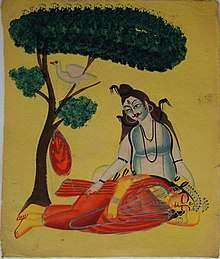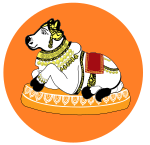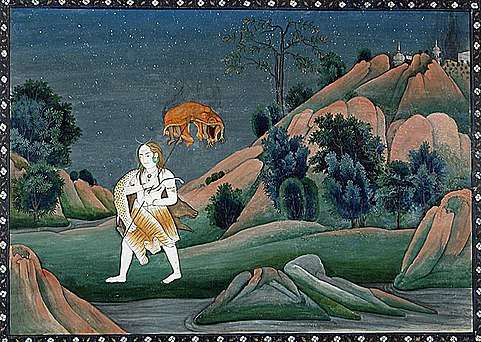Sati (Hindu goddess)
Sati (/ˈsʌtiː/, Sanskrit: सती, IAST: Satī), is also known as Dākṣāyaṇī (Sanskrit: दाक्षायणी, lit. daughter of Daksha). Tamil Tamil: தாட்சாயிணி Tāṭcāyiṇi , Telugu Dākṣāyaṇī Telugu: దాక్ష్యాయని. Kannada Kannada: ದಾಕ್ಷಾಯಣಿ Dakshayani , Sati is the goddess of marital felicity and longevity in Hinduism. An aspect of Adi Parashakti, Sati(Dakshayani) is the first consort of Shiva, the second being Parvati who is the reincarnation of Sati.
| Sati | |
|---|---|
Goddess of Power, Marital Felicity and Longevity | |
 Shiva mourns Sati | |
| Other names | Sati, Dakshakandari, Dakshayani, Dakshakanya, Bhavani, Dakshayajna Vinashini |
| Affiliation | Adi Parashakti, Shakti, Parvati |
| Abode | Mount Kailash |
| Personal information | |
| Parents | Prajapati Daksha |
| Siblings | etc |
| Consort | Shiva |
In Hindu legend, both Sati and Parvati, successively play the role of bringing Shiva away from ascetic isolation into creative participation with the world.[1][2]
| Part of a series on |
| Shaivism |
|---|
 |
|
Scriptures and texts
|
|
Philosophy
|
|
Practices |
|
Schools
Saiddhantika Non - Saiddhantika
|
|
Related
|
Purana
Queen Prasuti desired a daughter, Lord Brahma advised her and her husband Daksha to meditate upon the Goddess Adi-Parashakti. They gave up their royal robes, put on the guises of saints, and sat in a forest and meditated upon Goddess Adi-Parashakti. After a long time, Goddess Adi-Parashakti appeared awakening Daksha and Prasuti from their penance. Adi Parashakti invited them to request the desired boon from her, Daksha asked the Goddess to take birth again as their daughter. The Goddess gave them their consent but also gave them a warning that if ever she should be insulted, she would take up her Celestial form and disown them. Daksha and Prasuti agreed to take care of her.
Back in their palace, Adi Parashakti again took human birth at the bidding of Lord Brahma. Daksha and Prasuti named their daughter Sati. Daksha was a son of Brahma and a great king in his own right. Also known as Dakshayani (being daughter of Prajapati Daksha), Sati was a newborn to Daksha and Prasuti's 23 daughters. In bidding of Adi-Parashakti to take human birth, Brahma's design was that she would please Shiva with humble devotions and wed him. It was natural that Sati, even as a child, adored the tales and legends associated with Shiva told by sage Narada and grew up an ardent devotee. As she grew to womanhood, the idea of marrying anyone else, as intended by her father, became unfair to her.
To win the regard of the ascetic Shiva, the daughter of king Daksha forsook the luxuries of her father's palace and retired to a forest, there to devote herself to austerities and the worship of Shiva. So rigorous were her penances that she gradually renounced food itself, at one stage subsisting on one leaf a day, and then giving up even that nourishment; this particular abstinence earned her the name Aparna. Her prayers finally bore fruit when, after testing her resolve, Shiva finally acceded to her wishes and consented to make her his bride.
An ecstatic Sati returned to her father's home to await her bridegroom, but found her father less than elated by the turn of events. The wedding was however held in due course, and Sati made her home with Shiva in Kailash. Daksha, depicted in legend as an arrogant king, did not get on with his renunciative son-in-law and basically cut his daughter away from her natal family. Daksha organized a yagna ritual and invited all the Gods, Goddesses and princes. But he did not invite Shiva or Sati because he was unhappy that his daughter had married an ascetic Shiva. Sati learnt about the yagna and asked Shiva to go with her. When Shiva refused, Sati insisted upon going and was escorted by Shiva's troops to her father's kingdom. Upon reaching, Daksha got angry on seeing her and yelled at her telling her she was not welcome. Sati tried to make him understand but to no avail.
It is said that when Daksha did not stop yelling, the angered Sati took the form of the goddess, Adi Parashakti. Lightning and thunder threatened to destroy the Earth. All sorts of calamities arose as Mother Earth couldn't bear her strong radiance and power. The Gods, saints, sages, her mother, father and her sisters trembled in fear and respectfully saluted her, who was the Mother of the Universe (Jagadamba). Adi Parashakti introduced herself as the Eternal Power to Daksha and cursed him to be killed by Shiva, inclusive of all the Gods, princes and Goddesses. She cursed the yagna ritual, that it will never be completed, that Tamas would subdue its Sattvik nature.
She declared that from that moment, she renounces all the mortal relationships, nothing binds her.
She gave her final salutations to her husband Lord Shiva, and the mother of this mortal body, and then she prayed, hoped, that she be reborn to a father, whom she could respect.
So saying, Devi Sati immolated her mortal body through the invocation and provocation of her yogic powers.
As the Tatva of Shakti left the mortal shell, the mortal body of Devi Sati collapsed to the floor in scorching flames.
Angered and grief-stricken Shiva learnt about Sati's death and he rendered a terrible "Tandava" or dance of destruction, the more Shiva danced, the more destruction arose. Later, Shiva pulled two locks of hair and fell it on the ground. One arose Virabhadra, Shiva's destructive and terrible incarnation, having eight hands holding weapons and possessing a dark complexion. The second arose Bhadrakali, the Supreme Goddess's violent and intense incarnation, having eighteen hands holding weapons like a discus, dagger, trident, spear, mace, scimitar, sword, vajra, conch shell, demon head, drinking vessel, goad, waterpot, cleaver, shield, bow and arrow. Shiva ordered them to wreak havoc. Virabhadra and Bhadrakali were assisted by eight other Goddesses named Kali, Katyayini, Chamunda, Ishaani, Mundamardini, Bhadra, Vaishnavi and Twarita who appeared at their side. In other versions, it was said that first Virabhadra arose and after he was held captive by Vishnu, who was protecting Daksha since he was Vishnu's devotee and the Lord had promised him protection in time of need, Shiva created Bhadrakali who freed Virabhadra and was embedded in him and rendered him more powerful.
Daksha himself was decapitated by Virabhadra, while, others fell upon Daksha and Bhrigu's demon armies. After the night of horror, Shiva, the all-forgiving, restored all those who were slain to life and granted them his blessings. Even the abusive and culpable Daksha was restored both his life and his kingship. His severed head was substituted for that of a goat. Having learned his lesson, Daksha spent his remaining years as a devotee of Shiva. Out of grief and sorrow, Shiva carried Sati's body reminiscing their moments as a couple, and roamed around the universe with it. Vishnu had cut her body into 51 body parts using his Sudarshana Chakra which fell on Earth to become holy spots to pray to the Goddess named Shakti Peeths, to complete this massively long task, Lord Shiva took the form of Bhairava.
Entirely all of her body parts were the symbolism of each manifestation of Goddess Adi-Parashakti, Bhairava has incarnated himself to protect her Shakti Peeths in different forms for the protection from the evil forces. After long interval, Adishakti was reborn as Parvati, who was also known as Uma or Hemavati, daughter of Himavan, king of the mountains, and his wife Menavati. This time, she was born the daughter of a father whom she could respect, a father who appreciated Shiva ardently. Naturally, she grew up to be a beautiful woman and harboured a sincere love and devotion to Shiva. In course of time, Parvati began to love Shiva with her entire being. She too went to the forest to do meditation to please her beloved, Lord Shiva and to attain him again as her husband. Lord Shiva consented to make her his bride once more. In course of time, she married Lord Shiva and gave birth to Karttikeya, Ashokasundari and the gana headed god Ganesha.
Legend
Daksha yajna and self-immolation

Daksha once organized a grand yajna to which all the Gods were invited, with the exception of Sati and Shiva. Wanting to visit her parents, relatives and childhood friends, Sati sought to rationalize this omission. She reasoned within herself that her parents had neglected to make a formal invitation to them only because, as family, such formality was unnecessary; certainly, she needed no invitation to visit her own mother and would go anyway. Shiva sought to dissuade her, but she was resolved upon going; he then provided her with an escort of his ganas and bid her provoke no incident.
Sati was received coldly by her father. They were soon in the midst of a heated argument about the virtues (and alleged lack thereof) of Shiva. Every passing moment made it clearer to Sati that her father was entirely incapable of appreciating the many excellent qualities of her husband who was a god himself. The realization then came to Sati that this abuse was being heaped on Shiva only because he had wed her; she was the cause of this dishonour to her husband. She was consumed by rage against her father and loathing for his mentality. Her intense anger made her assume the celestial form of Adishakti whereby she terrorized all who were present there and her anger wrought havoc upon the Earth. Introducing herself to everyone, she cursed Daksha to die at Shiva's hands. Later, remembering her husband she called up a prayer that she may, in a future birth, be born the daughter of a father whom she could respect, Adishakti burnt Sati's body because of her radiance and heat as she was the Goddess of all energy and power(Shakti) (or) Sati invoked her yogic powers or yogic Agni which was attained by her due to severe devotion or puja done by her and immolated herself.
Shiva's rage

Shiva sensed this catastrophe, and his rage was incomparable. He loved Sati more than any and would never love any other woman after her. He danced the terrible Tandava or Rudratandava, a terrible dance of destruction and the power of his dance wrought havoc upon the Earth and threatened to give rise to Pralaya or the Great Destruction. He realized that Daksha had indirectly, killed Sati by his abuses and insults. In his terrible anger, he pulled a lock of hair (jata) and threw it on the ground from which arose Virabhadra and Bhadrakali, or collectively Manbhadra, two ferocious creatures who wreaked havoc and mayhem on the scene of the horrific incident. Nearly all those present were indiscriminately felled overnight. Daksha himself was decapitated.
According to some traditions, it is believed that an angry Shiva performed the fearsome and awe-inspiring Tandava dance with Sati's charred body on his shoulders. During this dance, Sati's body came apart and the pieces fell at different places on earth. According to another version, Shiva placed Sati's body on his shoulder and ran about the world, crazed with grief. The Gods called upon the God Vishnu to restore Shiva to normalcy and calm. Vishnu used his Sudarshana Chakra to dismember Sati's lifeless body, following which Shiva regained his equanimity. Both versions state that Sati's body was thus dismembered into 51 pieces which fell on earth at various places. Several different listings of these 51 holy places, known as Shakti Peethas, are available; some of these places have become major centers of pilgrimage as they are held by the Goddess-oriented Shakta sect to be particularly holy. Besides 51 main Shakti peethas, some small peethas like Bindudham came into existence which are due to Sati's fallen blood drops.
After the night of horror, Shiva, the all-forgiving, restored all those who were slain to life and granted them his blessings. Even the abusive and culpable Daksha was restored both to life and to kingship. His severed head was substituted for that of a goat. Having learned his lesson, Daksha spent his remaining years as a devotee of Shiva.
Aftermath
Dakshayani was reborn as Parvati, daughter of Himavat, king of the mountains, and his wife, Mena. This time, she was born the daughter of a father whom she could respect, a father who appreciated Shiva ardently. Naturally, Parvati sought and received Shiva as her husband. This legend appears in detail in Tantra literature, in the Puranas and in Kālidāsa's lyrical Kumārasambhava, an epic that deals primarily with the birth of Kartikeya.
Pilgrimage
Kottiyoor Festival
The mythology of Daksha Yaga and Sati's self-immolation had immense significance in shaping the ancient Sanskrit literature and even had impact on the culture of India. It led to the development of the concept of Shakti Peethas and there by strengthening Shaktism. Enormous mythological stories in puranas took the Daksha yaga as the reason for its origin. It is an important incident in Shaivism resulting in the emergence of Shree Parvati in the place of Sati Devi and making Shiva a grihastashrami (house holder) leading to the origin of Ganapathy and Subrahmanya.[3]
Shakti Peethas are shrines or divine places of the Mother Goddess. These are places that are believed to have enshrined with the presence of Shakti due to the falling of body parts of the corpse of Sati Devi, when Lord Shiva carried it and wandered throughout Aryavartha in sorrow. There are 51 Shakti Peethas linking to the 51 alphabets in Sanskrit. Nandikeshwari Temple is one of them.
Kottiyoor Vysakha Mahotsavam, a 27‑day yagnja ceremony, conducted in the serene hilly jungle location in North Kerala yearly commemorating the Daksha Yaga. It is believed that Sati Devi self immolated in this location and apparently this is the location of Daksha Yaga. The pooja and rituals were classified by Shri Sankaracharya.[4]
See also
- Sati (practice)
- Hindu deities
- The Levite's Concubine, Biblical figure cut into 12 pieces after her death
Notes
- Kinsley, David (1987, reprint 2005). Hindu Goddesses: Visions of the Divine Feminine in the Hindu Religious Tradition, Delhi: Motilal Banarsidass, ISBN 81-208-0394-9, p.38
- Kinsley, David (1987, reprint 2005). Hindu Goddesses: Visions of the Divine Feminine in the Hindu Religious Tradition, Delhi: Motilal Banarsidass, ISBN 81-208-0394-9, p.35
- "Kottiyoor Devaswam Temple Administration Portal". kottiyoordevaswom.com/. Kottiyoor Devaswam. Retrieved 20 July 2013.
- "Navadurga | 9 Swaroop of Maa Durga Hindu Devi knows as Navadurga". MaaDurga. 2019. Retrieved 6 May 2019.




